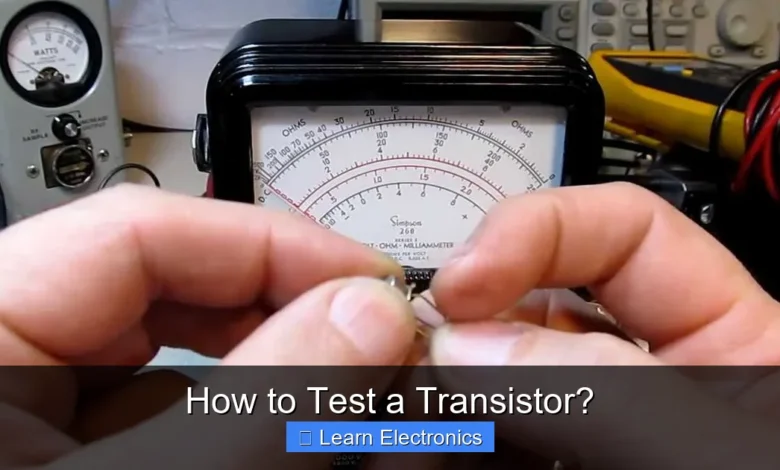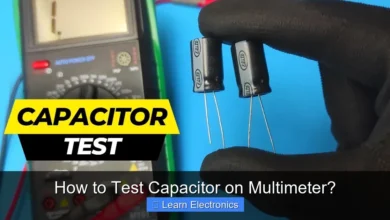How to Test a Transistor?

How to Test a Transistor? Determining the functionality of a transistor is a fundamental skill in electronics troubleshooting, typically involving a multimeter in diode test mode or a dedicated component tester. This essential practice ensures that the semiconductor device is operating correctly, preventing issues in circuit performance.
Understanding the proper methods for testing these critical components allows hobbyists and professionals alike to diagnose faults accurately and maintain the reliability of electronic systems.
Quick Answers to Common Questions
How can I quickly tell if my transistor is working or not?
The fastest way to test a transistor is using a multimeter’s diode test function to check the PN junctions between its base, collector, and emitter for correct voltage drops, indicating if it’s open, shorted, or functional.
What’s the essential tool I’ll need to test a transistor?
A digital multimeter (DMM) with a diode test function is your go-to device when you want to test a transistor, as it allows you to accurately measure the voltage drop across its internal junctions.
Can I test a transistor while it’s still on the circuit board?
While you *can* attempt to test a transistor in-circuit, it’s often more reliable to desolder at least one leg or the entire component first to avoid misleading readings from other connected components.
📑 Table of Contents
Understanding Transistor Basics
Before diving into the testing process, it’s crucial to have a foundational understanding of what transistors are and how they operate. Transistors are semiconductor devices used to amplify or switch electronic signals and electrical power. They are the fundamental building blocks of modern electronic devices.
What is a Transistor?
Transistors come in various types, but the most common are Bipolar Junction Transistors (BJTs) and Field-Effect Transistors (FETs), specifically MOSFETs. Each type has a unique internal structure and operating principle:
- Bipolar Junction Transistors (BJTs): These are current-controlled devices with three terminals: Base (B), Collector (C), and Emitter (E). They come in two polarities: NPN and PNP. An NPN transistor requires a small positive current at its base to allow a larger current to flow from collector to emitter. A PNP transistor requires a small negative current at its base.
- Field-Effect Transistors (FETs): These are voltage-controlled devices with three terminals: Gate (G), Drain (D), and Source (S). MOSFETs (Metal-Oxide-Semiconductor FETs) are particularly prevalent. FETs control current flow between the drain and source by applying a voltage to the gate. They are further classified into N-channel and P-channel, and enhancement-mode or depletion-mode.
Why Transistor Testing is Essential
Transistors can fail for various reasons, including electrical overstress, overheating, electrostatic discharge (ESD), or simply age. A faulty transistor can cause a circuit to malfunction, perform erratically, or fail completely. Regularly checking these components helps in:
- Troubleshooting: Pinpointing failed components in a non-functional circuit.
- Quality Control: Verifying new components before integration into a project.
- Repair: Replacing defective transistors to restore functionality.
Essential Tools for Transistor Testing
Accurate testing requires the right equipment. While specialized testers exist, a standard digital multimeter (DMM) is often sufficient for basic checks.
Digital Multimeter (DMM)
A DMM is the most common tool for checking transistors. It typically includes modes for measuring voltage, current, resistance, and continuity, as well as a dedicated diode test mode, which is crucial for BJT testing. Some advanced DMMs also feature an hFE (current gain) test function, which is particularly useful for BJTs.
- Diode Test Mode: This mode applies a small voltage across the component and measures the voltage drop, indicating whether it behaves like a diode. This is invaluable for checking the internal junctions of BJTs.
- Resistance Mode: Useful for checking for shorts or open circuits within the transistor.
Transistor Tester / Component Tester
For more comprehensive analysis, a dedicated transistor tester or an all-in-one component tester (like those based on the popular ATmega-based designs) is ideal. These devices can automatically identify the component type (NPN, PNP, MOSFET, JFET), pinout, and provide detailed parameters such as hFE for BJTs, gate threshold voltage (Vgs(th)) for MOSFETs, and leakage currents.
Other Useful Tools
- Breadboard: For temporarily connecting transistors in simple test circuits.
- Power Supply: To provide bias voltages for more dynamic testing.
- Datasheets: Essential for understanding the specific pinout, parameters, and expected behaviors of a particular transistor.
Methods for How to Test a Transistor with a Multimeter
The most common and accessible method for checking transistors involves using a digital multimeter. The specific steps vary depending on whether you’re testing a BJT or a FET.
Testing Bipolar Junction Transistors (BJTs) with a Multimeter
BJTs can be thought of as two back-to-back diodes. For an NPN transistor, the base-emitter and base-collector junctions are like forward-biased diodes when the base is positive relative to the emitter and collector, respectively. For a PNP, it’s the opposite.
Identifying BJT Pins (Base, Collector, Emitter)
Before testing, you need to know which pin is which. Refer to the transistor’s datasheet for its specific pinout. Common packages like TO-92 (small signal) or TO-220 (power) have standard pin assignments, but always verify.
Diode Test Mode for NPN Transistors
- Set your DMM to diode test mode.
- Place the red (positive) probe on the Base pin.
- Place the black (negative) probe on the Emitter pin. You should read a voltage drop (typically 0.4V to 0.9V for silicon transistors). This is the forward voltage (Vf) of the base-emitter junction.
- Keep the red probe on the Base and place the black probe on the Collector pin. You should read a similar voltage drop (Vf) for the base-collector junction.
- Now, reverse the probes: Place the black probe on the Base and the red probe on the Emitter. You should get an “OL” (Open Line) or “1” reading, indicating an open circuit (reverse-biased junction).
- Keep the black probe on the Base and place the red probe on the Collector. You should also get an “OL” reading.
- Test the collector-emitter junction: Place probes across Collector and Emitter in both directions. You should get an “OL” reading in both directions, as there shouldn’t be a diode junction there.
Conclusion for NPN: A good NPN transistor will show a low voltage drop (around 0.6-0.7V) from Base to Emitter and Base to Collector (red on Base, black on E/C), and “OL” in all other six combinations.
Diode Test Mode for PNP Transistors
The process is similar to NPN, but the polarities are reversed:
- Set your DMM to diode test mode.
- Place the black (negative) probe on the Base pin.
- Place the red (positive) probe on the Emitter pin. You should read a voltage drop (0.4V to 0.9V).
- Keep the black probe on the Base and place the red probe on the Collector pin. You should read a similar voltage drop.
- Reverse the probes: Place the red probe on the Base and the black probe on the Emitter. You should get an “OL” reading.
- Keep the red probe on the Base and place the black probe on the Collector. You should also get an “OL” reading.
- Test the collector-emitter junction: Place probes across Collector and Emitter in both directions. You should get an “OL” reading in both directions.
Conclusion for PNP: A good PNP transistor will show a low voltage drop (around 0.6-0.7V) from Emitter to Base and Collector to Base (black on Base, red on E/C), and “OL” in all other six combinations.
Resistance Test for Shorts and Opens
While the diode test is more informative, a quick resistance test can identify obvious shorts or opens:
- Set your DMM to resistance mode (Ohms).
- Measure resistance between all three pin combinations (B-E, B-C, C-E) in both directions.
- For a good BJT, you should read very high resistance (megohms or OL) in most combinations. A low resistance (a few ohms) in any reverse-biased junction or across C-E indicates a short. An “OL” where a diode drop is expected indicates an open circuit.
Testing Field-Effect Transistors (FETs) with a Multimeter
FETs, especially MOSFETs, are voltage-controlled and have a gate that is electrically isolated from the channel. This makes their multimeter testing slightly different.
Identifying FET Pins (Gate, Drain, Source)
Always consult the datasheet for the specific FET’s pinout.
Testing JFETs
JFETs have a gate-channel junction that behaves like a diode. For N-channel JFETs, the gate-source and gate-drain junctions are like reverse-biased diodes when the gate is positive relative to the source/drain. Testing involves:
- Set DMM to diode test mode.
- Place red probe on Source, black probe on Gate. You should get a diode drop.
- Place red probe on Drain, black probe on Gate. You should get a diode drop.
- Reverse probes: black on Source/Drain, red on Gate. You should get “OL”.
- Measure between Drain and Source in both directions. You should read a low resistance (for the channel), but it won’t be an “OL” unless it’s completely open. The exact resistance depends on the JFET’s characteristics.
Conclusion for JFET: A good JFET will show diode behavior between the Gate and Source/Drain in one direction and an open circuit in the reverse. The D-S channel should show some resistance.
Testing MOSFETs (Enhancement vs. Depletion)
MOSFET gates are insulated, so the gate-source and gate-drain should always read “OL” in diode or resistance mode, indicating no direct current path. The main concern is whether the gate insulation is intact and if the channel can be turned on/off.
- Set DMM to diode test mode or high resistance mode (e.g., 2MΩ).
- Measure between Gate and Source, and Gate and Drain in both directions. You should always get an “OL” or extremely high resistance, indicating a healthy, insulated gate. Any low resistance or diode drop here suggests a damaged gate.
- Measure between Drain and Source in both directions. You should see “OL” or high resistance for an N-channel enhancement mode MOSFET that is OFF. Some MOSFETs have an internal body diode (usually between Drain and Source). You might see a diode drop in one direction (red on Drain, black on Source for N-channel or vice-versa for P-channel), and “OL” in the other.
- Turning on an N-channel enhancement MOSFET:
- Place the black probe on the Source.
- Place the red probe momentarily on the Gate (this charges the gate capacitance, turning the MOSFET ON).
- Move the red probe from the Gate to the Drain. You should now read a low resistance (or continuity beep), indicating the channel is conducting.
- To turn it OFF, momentarily touch the red probe to the Source and the black probe to the Gate (discharging the gate), then re-measure D-S; it should return to high resistance/OL.
Conclusion for MOSFET: A good MOSFET has an isolated gate (OL to D/S). An enhancement-mode MOSFET should be able to be turned ON and OFF by charging/discharging its gate capacitance, showing a low D-S resistance when ON and high when OFF. Watch for the body diode if present.
Advanced Methods for Testing Transistors
While a multimeter is excellent for basic pass/fail tests, specialized equipment offers more detailed insights into a transistor’s performance characteristics.
Advantages of Dedicated Testers
Dedicated component testers automate much of the manual work and provide quantitative data. They can:
- Automate Pin Identification: No need to consult datasheets for pinouts.
- Measure hFE: For BJTs, this is the forward current gain, a critical parameter for amplifier design.
- Measure V_f and Leakage Current: Provide precise forward voltage drops and reverse leakage currents, indicating subtle degradation.
- Measure Gate Threshold Voltage (Vgs(th)): For MOSFETs, this tells you the voltage required to turn the device on.
- Identify Type: Automatically determine if it’s NPN, PNP, N-MOS, P-MOS, JFET, diode, resistor, capacitor, etc.
Interpreting Results
A good tester will display numerical values. For example, a BJT tester might show hFE = 200, V_f = 0.65V. You’d compare these values to the transistor’s datasheet. Significant deviations (e.g., hFE much lower than specified, or high leakage current) indicate a degraded or faulty component.
Automated Component Identification
The practice of testing a transistor becomes much faster with an automated tester. You simply insert the component, press a button, and the tester provides all relevant information, including pin configuration, type, and key electrical parameters. This is especially useful when dealing with unmarked or salvaged components.
Common Issues and Troubleshooting Tips
When a transistor fails, it typically does so in one of a few predictable ways. Knowing these failure modes helps in diagnosis.
Open Circuits and Short Circuits
- Open Circuit: A complete break in one or more of the transistor’s junctions. A DMM will show “OL” or infinite resistance where a diode drop or specific resistance should be found. The transistor effectively acts as if it’s not connected.
- Short Circuit: An unintended low-resistance path between two or more terminals. A DMM will show very low resistance (near 0 Ohms) or a short beep in continuity mode where high resistance or a diode drop should be. This often means the transistor is permanently conducting or bypassing the intended path.
Leaky Transistors
A leaky transistor allows a small current to flow even when it should be off. This can be hard to detect with a basic DMM. A dedicated tester or a circuit test (measuring current when the transistor is supposed to be off) is usually needed. Leakage can cause unexpected power consumption or incorrect biasing in a circuit.
Gain Issues (Low hFE)
For BJTs, if the hFE (current gain) is significantly lower than specified in the datasheet, the transistor may still function but will not amplify signals effectively. This is best checked with a dedicated transistor tester or a DMM with an hFE function. A low hFE can cause reduced output power or signal weakness in amplifier circuits.
Here’s a quick summary table of common transistor failure symptoms:
| Failure Symptom | Multimeter Indication (Diode/Resistance Mode) | Likely Cause/Effect |
|---|---|---|
| Open Junction (e.g., B-E open in BJT) | “OL” or infinite resistance in all directions where a diode drop or low resistance is expected. | Transistor completely non-conductive; circuit open. |
| Short Circuit (e.g., C-E short in BJT) | Very low resistance (near 0 Ohms) or continuity beep between terminals that should be high resistance. | Transistor permanently “ON” or bypassing intended path; circuit always active or overloaded. |
| Damaged Gate (MOSFET) | Low resistance or diode drop between Gate and D/S where “OL” is expected. | Gate insulation compromised; MOSFET cannot be properly controlled, likely permanently ON or OFF. |
| Low hFE (BJT) | (Not directly detectable by diode/resistance test) Requires hFE test or in-circuit testing. | Transistor still functions but has poor amplification; reduced circuit performance. |
Always disconnect the transistor from the circuit before testing to avoid misleading readings from other components. When handling MOSFETs, be mindful of static electricity (ESD) as their gates are very sensitive and can be damaged by static discharge.
Conclusion
Mastering the testing of transistors is an indispensable skill for anyone involved in electronics. Whether you’re using a simple digital multimeter to check for basic functionality or a sophisticated component tester for in-depth analysis, understanding the principles and practical steps ensures accurate diagnosis and reliable repairs. Always refer to datasheets for specific pinouts and parameters, practice safe handling, especially with static-sensitive components, and remember that consistent practice will build your confidence and expertise in this fundamental aspect of electronics troubleshooting.
Frequently Asked Questions
What is the most basic way to test a transistor using a multimeter?
The simplest method involves using your multimeter’s diode test mode. For an NPN transistor, you should see a voltage drop (typically 0.5-0.7V) from base to emitter and base to collector when forward-biased, and open circuits in reverse. PNP transistors show similar drops from emitter to base and collector to base when reverse-biased.
How do I determine if a transistor is NPN or PNP and find its pinout?
Using the diode test, find the pin that conducts to the other two pins in one direction; this is your base. If your positive probe is on the base and it conducts to the others, it’s NPN; if the negative probe is on the base, it’s PNP. The higher reading (typically) identifies the collector, and the lower reading is the emitter.
Is it possible to test a transistor without removing it from the circuit board?
While you can perform some basic tests in-circuit, they are often unreliable due to other components connected in parallel. For accurate and definitive results, it is highly recommended to desolder the transistor and test it out of circuit.
What are common indicators of a faulty transistor?
A transistor is likely faulty if any junction (base-emitter or base-collector) shows a short circuit (zero resistance) in both directions or an open circuit (infinite resistance) in both directions. Leakage current, where the transistor conducts unexpectedly, also indicates a problem.
How can I test the gain (hFE) of a transistor?
Many multimeters have a dedicated hFE socket where you can plug in the transistor to get a direct reading of its current gain. Alternatively, you can build a simple test circuit to apply a known base current and measure the resulting collector current, then calculate hFE (Ic/Ib).



